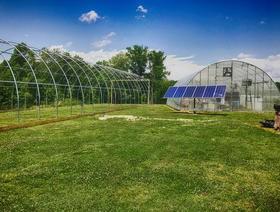White House to Fuel Coal Transition to Diversified Economies

By Robbie Harris
May 9, 2021 - For decades, a committed conglomeration of environmental activists in Virginia and around the country has been working toward this moment: A presidential promise to transition to clean energy and funding to create new economies in coal country.
The massive new White House report on how to re-invigorate and reimagine coal communities on the decline, rolled out almost on cue, just a few months after Joe Biden became president.

Ridgeview High School in Dickenson Co. powers its greenhouses with a solar installation.
Photo: Chelsea Barnes, Appalachian Voices
But this has been years in the planning for people like Tom Cormons, and armies of environmentalists around the country, who’ve spent decades preparing for this move, they call “The Just Transition” from extractive economies to regenerative ones.
“Considerable progress has been made and is being made. But the, the scale of the problem is so large.” Cormons is Executive Director of Appalachian Voices, an advocacy group for revitalizing coal country. “And one piece that's been missing is the right scale of engagement and investment from the federal government on this.”
But now, a federal working group has identified the 25 most coal dependent areas in the country. The top four of the most coal dependent places? All in Appalachia. And that means they’re on the list for economic and technological support from new and existing government funds, to make the transition to a new broader economy.
And that means, “This country is really giving back to communities that have powered the country for the past century.”
Now that 25 communities around the country hardest hit by coal mine and power plant closures have been selected for revitalization, the next step is town halls in each locality, to hear what people who live there say they need most.

